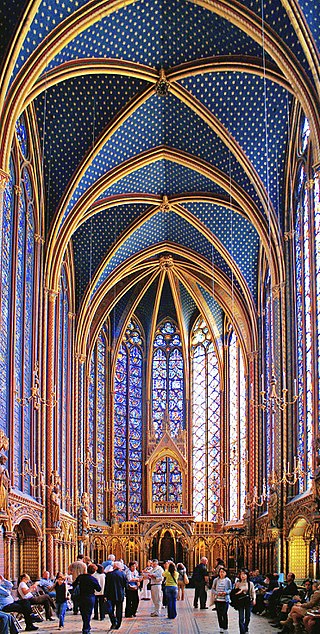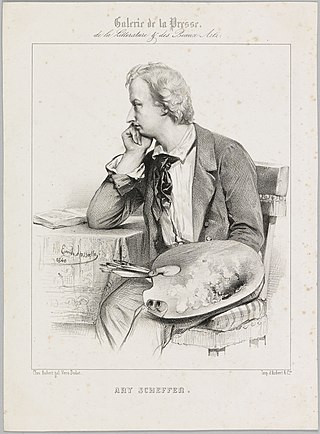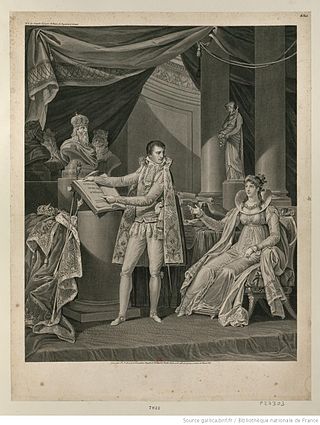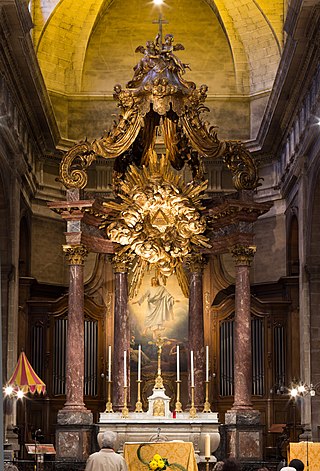
The Sainte-Chapelle is a royal chapel in the Gothic style, within the medieval Palais de la Cité, the residence of the Kings of France until the 14th century, on the Île de la Cité in the River Seine in Paris, France.
A number of alleged relics associated with Jesus have been displayed throughout the history of Christianity. While some individuals believe in the authenticity of Jesus relics, others doubt their validity. For instance, the sixteenth-century philosopher Erasmus wrote about the proliferation of relics, and the number of buildings that could be constructed from wooden relics claimed to be from the crucifixion cross of Jesus. Similarly, at least thirty Holy Nails were venerated as relics across Europe in the early 20th century. Part of the relics are included in the so-called Arma Christi, or the Instruments of the Passion.
The Holy Sponge is one of the Instruments of the Passion of Jesus. It was dipped in vinegar, most likely posca, a regular beverage of Roman soldiers, and offered to Jesus to drink from during the Crucifixion, according to Matthew 27:48, Mark 15:36, and John 19:29.

According to the New Testament, a woven crown of thorns was placed on the head of Jesus during the events leading up to his crucifixion. It was one of the instruments of the Passion, employed by Jesus' captors both to cause him pain and to mock his claim of authority. It is mentioned in the gospels of Matthew, Mark and John, and is often alluded to by the early Church Fathers, such as Clement of Alexandria, Origen and others, along with being referenced in the apocryphal Gospel of Peter.

Ary Scheffer was a Dutch-French Romantic painter. He was known mostly for his works based on literature, with paintings based on the works of Dante, Goethe, and Lord Byron, as well as religious subjects. He was also a prolific painter of portraits of famous and influential people in his lifetime. Politically, Scheffer had strong ties to King Louis Philippe I, having been employed as a teacher of the latter's children, which allowed him to live a life of luxury for many years until the French Revolution of 1848.

Jacques Gaillot is a French Catholic clergyman and social activist. He was Bishop of Évreux in France from 1982 to 1995. In 1995, Pope John Paul II removed him as head of his diocese because he publicly expressed controversial and heterodox positions on religious, political and social matters. These views earned Gaillot the popular nickname "the Red Cleric".

François Pascal Simon Gérard, titled as Baron Gérard in 1809, was a prominent French painter. He was born in Rome, where his father occupied a post in the house of the French ambassador, and his mother was Italian. After he was made a baron of the Empire in 1809 by Emperor Napoleon, he was known formally as Baron Gérard.
The Feast of the Crown of Thorns is a feast day of the Roman Catholic Church, for the Friday after Ash Wednesday. It is not universally observed.

The Relics of Sainte-Chapelle are relics of Jesus Christ acquired by the French monarchy in the Middle Ages and now conserved by the Archdiocese of Paris. They were originally housed at Sainte-Chapelle in Paris, France and are now in the cathedral treasury of Notre-Dame de Paris.

The Holy Thorn Reliquary was probably created in the 1390s in Paris for John, Duke of Berry, to house a relic of the Crown of Thorns. The reliquary was bequeathed to the British Museum in 1898 by Ferdinand de Rothschild as part of the Waddesdon Bequest. It is one of a small number of major goldsmiths' works or joyaux that survive from the extravagant world of the courts of the Valois royal family around 1400. It is made of gold, lavishly decorated with jewels and pearls, and uses the technique of enamelling en ronde bosse, or "in the round", which had been recently developed when the reliquary was made, to create a total of 28 three-dimensional figures, mostly in white enamel.
Jean Audran (1667-1756) was a French engraver and printmaker. The brother of Benoit, and the third son of Germain Audran, he was born at Lyons in 1667. After learning the rudiments of the art under his father, he was placed under the care of his uncle, the famous Gérard Audran, in Paris. Before he was twenty years of age he displayed uncommon ability, and became a very celebrated engraver. In 1706 he was made engraver to the king, with a pension and apartments at the Gobelins. The hand of a great master is discernible in all his plates; and without having attained the extraordinary perfection of Gérard Audran, his claim to excellence is very considerable. He died in 1756. His principal prints are:

Joseph Félix Henri Auvray (1800–1833) was a French historical painter.

Samuel Bernard, also known as Jacques-Samuel Bernard was a French miniature painter and engraver.

Hendrik Scheffer was a Dutch painter in the Romantic tradition who lived in France for most of his life. In France he is usually known as Henri Scheffer.

Féréol Bonnemaison was a French portrait painter, lithographer, restorer, and art dealer.

Jean Boulanger, a French line-engraver, son of the painter Olivier Boulanger and cousin to the painter of the same name, was born at Amiens in 1608 and baptized in Troyes in Champagne on 24 January 1608; he had five children with Marie Judon. He was documented in Paris in 1645 and resided in the parish of Saint-Etienne-du-Mont.

François Anne David (1741-1824), was a French line-engraver.

Pieter de Bailliu was a Flemish engraver.

Claude-Marie-Paul Dubufe (1790–1864) a French historical, genre and portrait painter, was born in Paris in 1790, and studied under Jacques-Louis David. His subjects were at first classical, and then scriptural. He then gave himself up to the painting of genre pictures and portraits. His reputation rests chiefly on his portraits, of which he produced a large number. Dubufe, who was the last representative of the school of David, died at Selle-Saint-Cloud in 1864.

Jean-Bruno Gassies (1786–1832), a French historical and genre painter, was born at Bordeaux.
















